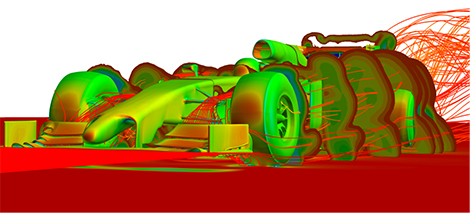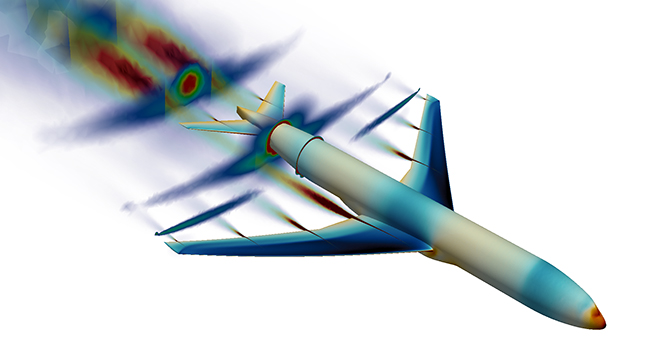Our Ongoing Swedish SHAPE Projects: Towards a Greener and Quieter Future in Vehicular Transport
Michaela Barth, PDC

The PRACE (Partnership for Advanced Computing in Europe) Research Infrastructure runs a program to help European small to medium-sized enterprises (SMEs) take advantage of the innovation possibilities opened up by high performance computing (HPC) techniques and technology. This SME HPC Adoption Programme in Europe is known as SHAPE. The third SHAPE Call for Proposals was held earlier this year and is supporting eight projects from European SMEs, two of which are Swedish.
The two successful Swedish companies are receiving two person months (PMs) worth of support each from Task 1 in PRACE work package 7 Applications Enabling and Support, which is called Enabling Applications Codes for PRACE Systems. Support is also being provided from within the Swedish PRACE partner, that is, by the Swedish National Infrastructure for Computing (SNIC) with PDC acting in the executive and coordinating role.
Interestingly enough, in this round of the SHAPE calls, the Swedish companies that were awarded projects – Airinnova and Creo Dynamics – are both focusing on aerodynamic flow field simulations using accurate, life-like Computational Fluid Dynamics (CFD) simulations that will soon provide all of us with greener and much quieter methods of transport.

Airinnova is a start-up company focusing on providing advanced computational technology for cutting-edge aircraft preliminary design, computational aerodynamics, and multi-disciplinary optimization.
The company is developing computational solutions for aerodynamic shape optimization, which is an important task in aircraft design. The goal is to design a lighter, greener, and quieter aeroplane by reducing drag especially at high speeds. Aerodynamic shape optimization for reduced drag requires a large number of CFD solutions, and computational power is a limiting factor. Current ideas for surrogate modelling are being developed to improve computational efficiency.
The aerodynamic shape optimization problem is highly non-linear. Gradient-based methods are comparatively efficient, but are myopic and deliver solutions – if at all – that are close to the baseline shape. Therefore, other methods (such as genetic algorithms or other non-local schemes) are also being investigated, albeit that they involve CFD analysis for many more candidate shapes. Accurate CFD runs (for example, the Reynolds-average Navier-Stokes equations or RANS solver with turbulence models) must be parallelized to reduce the run-time.
Within its SHAPE project Airinnova will focus on carrying out high-fidelity RANS aerodynamic shape optimization for the NASA common research model (CRM) aircraft based on the gradient-based optimization algorithms, using different CFD solvers and methods while getting essential benchmarking help in doing the performance analysis using the proposed CFD solvers.

Creo Dynamics, which is based in Linköping, is an engineering company with core competence in fluid mechanics, acoustics and structural dynamics. Creo participates frequently in national and international research programs where the focus is often on the development of new emerging technologies for the automotive or aerospace industry.
They have been awarded a SHAPE contract for their project proposal “Large scale aero-acoustic applications using open-source CFD”.
Together with researchers and application experts from the KTH Royal Institute of Technology and PDC, Creo engineers will work on the development and tuning of simulation processes based entirely on open-source software. The aim is to demonstrate an efficient and robust CFD workflow for real-life applications deployed in parallel at large scale.
From the side of Creo Dynamics, the project will be coordinated by Torbjörn Larsson, who was one of the main driving forces for introducing CFD in Formula One racing during the early 2000s and who was head of the CFD departments at BMW Sauber F1 and Scuderia Ferrari F1 for over a decade.

Torbjörn explains that “The chosen test case will be demanding, challenging and of high industrial relevance. A prime focus is on the implementation of efficient strategies for computer-aided design (CAD) handling and meshing in distributed mode on large parallel clusters. The PDC expertise should help us in identifying critical bottlenecks and performance deficits in the processes, and give guidance and assistance in finding improved solutions for a fine tuning of the overall methodology”. Results from the project will be made public to showcase the technology and encourage new users to adopt and invest in HPC and open-source software.
The envisaged CFD methodology is expected to deliver simulation accuracy in line with current industry best practices at a considerably lower cost.
For more information about the project, please visit CREO at www.creodynamics.com .
PDC will help these two industrial business partners to assess how the use of HPC can increase their competitiveness in this exciting field of innovative business even more.
